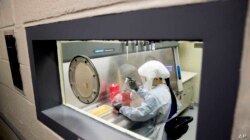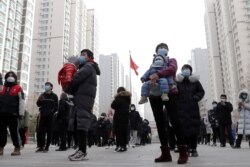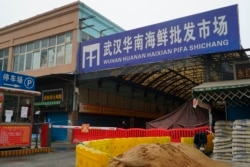This fact check has been corrected.
On March 30, the World Health Organization (WHO) released a Global Study of the Origins of SARS-CoV-2, the virus that causes COVID-19. A joint China-WHO team conducted that study in Wuhan, China, in January-February 2021.
The report said no firm conclusion could be drawn about what role the Huanan Seafood Wholesale Market in Wuhan, to which many early cases were traced, played in the origin of the outbreak, or how the virus was introduced there.
The original source of viral transmission to humans also remains unknown.
Still, WHO Director-General Adhanom Ghebreyesus said that while the team had visited several laboratories in Wuhan to determine whether “the virus entered the human population as a result of a laboratory incident,” their assessment was “not extensive enough.”
“Further data and studies will be needed to reach more robust conclusions,” Ghebreyesus said. “Although the team has concluded that a laboratory leak is the least likely hypothesis, this requires further investigation, potentially with additional missions involving specialist experts, which I am ready to deploy.”
He added: “Let me say clearly that as far as WHO is concerned all hypotheses remain on the table.”
China’s Foreign Ministry spokesperson Hua Chunying was asked about Ghebreyesus’ comments during a March 31 press conference.
She said that “there is always a question mark over lab leak,” adding that there had been reports of early outbreaks across the world.
“In addition to Fort Detrick, [a] certain country has more than 200 biological bases around the world,” Hua said. “So, I think, if necessary, scientists should be allowed to work in a scientific spirit with relevant laboratories around the world.”
The previous day, she more directly insinuated that the U.S. Army lab at Fort Detrick, Maryland, was the source of the pandemic.
“If you think about it, since the outbreak of COVID-19, how many lies and rumors and lies against China have been told by certain politicians, leaders and lawmakers in the US and Europe, including those about China's lab leak and making of the virus? I wonder how many of those lies you have checked? Besides, there is still a big question mark over the lab at Fort Detrick,” she said.
That is false. Chinese state media and officials have repeatedly floated conspiracy theories or promoted unfounded vectors of infection like cold chain storage to deflect claims that China was the source of the pandemic.
Polygraph.info has previously debunked conspiracy theories involving Fort Detrick, which typically rely on anonymous “netizens” and non-existing reports as sources.
In July 2019, the U.S. Centers for Disease Control and Prevention ordered that the U.S. Army Medical Research Institute of Infectious Diseases (USAMRIID) at Fort Detrick be shut down over safety concerns, saying it did not have “sufficient systems in place to decontaminate wastewater.”
The biodefense center was studying germs and toxins “that could be used to threaten the military or public health,” and was also investigating “disease outbreaks,” The New York Times reported. The “select agents” being studied at the center included Ebola, smallpox, anthrax and plague, and the poison ricin.
However, according to media reports, nobody was exposed, and nothing leaked outside the facility, which was fully reopened in March 2020.
Likewise, no evidence has been put forward linking Fort Detrick to the coronavirus outbreak.
After analyzing the SARS-CoV-2 genome, a team of scientists led by immunology and microbiology researcher Kristian Anderson determined that SARS-CoV-2 is of natural origin.
“Our analyses clearly show that SARS-CoV-2 is not a laboratory construct or a purposefully manipulated virus,” the team wrote.
Beijing earlier pushed the conspiracy theory that infected U.S. soldiers could have brought the virus to Wuhan.
China has also been the target of conspiracy theories that COVID-19 was engineered in a Chinese biological weapons laboratory.
U.S. officials, and others have posited that the virus was potentially leaked from a Chinese lab, or the product of "gain of function" research, which involves modifying the genomes of viruses.
Peter Daszak, a disease ecologist with EcoHealth Alliance and a member of the WHO delegation, told NPR in March that wildlife farms in southern China are the most likely source of the pandemic.
He said evidence had shown that these farms, which the government shut down in February 2020, were supplying vendors at Wuhan’s Huanan Wholesale Seafood Market.
Linfa Wang, a virologist who studies bat viruses at Duke-NUS Medical School in Singapore and a member of the WHO investigative team, told NPR there was “massive” viral transmission at the market.
"In the live-animal section, they had many positive samples," Wang said. "They even have two samples from which they could isolate live virus.”
Daszak said authorities closed that supply-chain pathway because it was likely a route for the virus to spread to Wuhan.
France’s Reporterre, a news site which covers environmental and social issues, reported in January 2021 that it was increasingly plausible COVID-19 originated in fur farms, with minks and raccoon dogs likely intermediate species.
Reporterre said that China had resisted that route of inquiry to protect its $20 billion annual fur industry.
Christian Drosten, who directs the Institute of Virology at the Charité Hospital in Berlin and helped identify the SARS virus in 2003, told the Guardian in April 2020: “If somebody gave me a few hundred thousand bucks and free access to China to find the source of the virus, I would look in places where raccoon dogs are bred.”
The WHO-China joint inquiry concluded that the virus most likely originated in bats or pangolins and was passed on to another animal, from which it then spread to people.
While recognizing “direct spillover from bats to humans may have occurred,” it said that “[c]andidate intermediate host species may include mink, pangolins, rabbits, raccoon dogs and domesticated cats that can be infected by SARS-CoV-2 ... or species such as civets and ferret badgers and related mustelids that were shown to be infected by SARS-CoV during the outbreak in Guangdong Province, China.”
The report also said it was “extremely unlikely” the pandemic originated in a laboratory but added that “laboratory accidents do happen.”
Prior to China’s centralization of all COVID-19 publications in February 2020, with all research needing approval from a Chinese government-controlled task force prior to publication, two Chinese scientists speculated in a since-removed paper that “the killer coronavirus probably originated from a laboratory in Wuhan.”
According to that paper, studies of horseshoe bats were conducted at the Wuhan Center for Disease Control and Prevention, and “surgery was performed on the caged animals, and the tissue samples were collected for DNA and RNA extraction and sequencing.”
It added: “The tissue samples and contaminated trashes were source of pathogens. They were only ~280 meters from the seafood market.”
The WHO report made no mention of those claims but noted that the Wuhan CDC laboratory moved on December 2, 2019, to a new location near the Huanan market. It added that “moves can be disruptive for the operations of any laboratory.”
According to the joint study, the Wuhan CDC lab itself did not report “any disruptions or incidents caused by the move.” It stated that the Wuhan Institute of Virology (WIV) sequenced the closest known relative to SARS-CoV-2 — CoV RaTG13, which infects horseshoe bats.
But it also said there “is no record of viruses closely related to SARS-CoV-2 in any laboratory before December 2019, or genomes that in combination could provide a SARS-CoV-2 genome.”
In January, a U.S. State Department fact sheet said the U.S. government had “reason to believe that several researchers inside the WIV became sick in autumn 2019 … with symptoms consistent with both COVID-19 and common seasonal illnesses.” It further charged China was conducting secret military research there. China denies those claims.
Meantime, the WHO report has faced international criticism. Thirteen governments, including the United States, said in a statement on March 30 that the study had been “significantly delayed and lacked access to complete, original data and samples.”
The New York Times cited WHO investigators saying that Chinese scientists refused to share raw data on the initial coronavirus outbreak, and that Beijing’s unwillingness to release information was hindering efforts to prevent future outbreaks.
That information included blood sample data that could potentially clarify how widely the virus circulated in China in 2019. The Times report was published in February but has since been disputed.
China was also criticized for controlling which WHO investigators were allowed into the country.
Correction: An earlier version of this article mistakenly said the WHO rejected the idea that SARS-CoV-2 was manmade. In fact, that was the finding of a genetic analysis reported in the journal Nature Medicine. Polygraph.info regrets the error.









